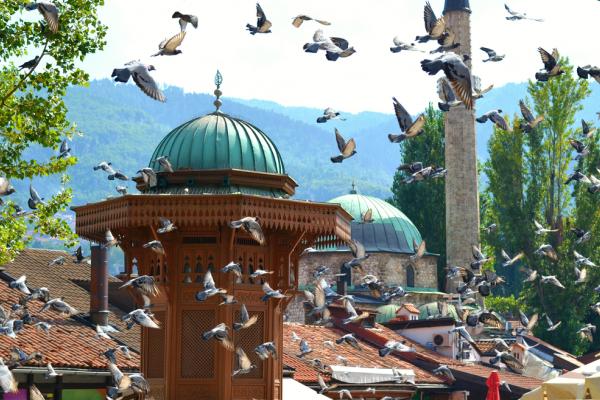On Dec. 8, in this most perilous of times, Pope Francis caught the Catholic Church and the world by surprise with his World Day of Peace declaration for 2017. Never before has a declaration for this day so clearly stated nonviolence as an imperative rather than a personal option for some.
Since Pope Paul VI first proclaimed Jan. 1 as a “World Day of Peace” 50 years ago, popes have issued statements outlining their ethic of peace in the context of Catholic doctrine and tradition.
This year, Pope Francis’ message — "Nonviolence: A Style of Politics for Peace" — presents nonviolence as a practical political program, not only for spiritual growth and personal relationships but also as the way that nations need to govern themselves and as the basis for international relations. In it, he writes:
“We know that this ‘piecemeal’ violence, of different kinds and levels, causes great suffering… Where does this lead? Can violence achieve any goal of lasting value? Or does it merely lead to retaliation and a cycle of deadly conflicts that benefit only a few ‘warlords’?”
The text is as striking for how it diverges with heads of state on foreign policy as for how it diverges with some influential Catholic thinkers on the role of warfare in the church. Ron Rolheiser, a Catholic priest and theologian who writes a popular column on spirituality and ethics, addressed the question in a popular column in June 2015, “Of Guns and Pacifism,” saying an ethic of pacifism was unrealistic. He writes:
“…How realistic is it to refuse to arm ourselves? How realistic is it to pray to be disarmed? …From Dorothy Day to Martin Luther King, from Mother Teresa to Christian de Cherge, from Daniel Berrigan to Larry Rosebaugh, we have been gifted by the witness of Gospel-inspired persons who, in the face of physical threat and violence, chose to risk their lives rather than pick up a gun.
…It might be said that those who argue for radical pacifism can do so only because they are already protected by police and soldiers with guns. It’s not too much of a stretch to say that, except for the guns and weapons that protect us, we all stand helpless before the criminals and psychopaths of this world.”
In other words, pacifism can not reasonably be the norm, or it will be the end of the human race, one way or another.
On this World Day of Peace, Pope Francis differs from Fr. Rolheiser and Cardinal George, as would certainly the pacifists whose names Fr. Rolheiser invokes.
“Nonviolence is sometimes taken to mean surrender, lack of involvement and passivity, but this is not the case,” Pope Francis writes.
I am writing this on Christmas Day, and I note that Rolheiser’s and others’ insistence that armed force is needed to “protect” the innocent is based on their understanding of what happened that first Christmas: “The Infant-Christ, was still in danger, is still in danger, is still mortally threatened, and is still being tracked down, right to this day.”
Perhaps the Christ child is always threatened and vulnerable — but who are the “friends of Herod” Rolheiser mentions, and who are the “the criminals and psychopaths” who are trying to kill the Child?
On Dec. 23, members of Upstate Drone Action dramatized the continuing threat to the Child Jesus in the gates of Hancock Field Air National Guard Base in Dewitt, N.Y., a facility that conducts armed drone attacks.
“If Herod had a Reaper [drone], Jesus, Mary, and Joseph and I would have been incinerated,” the activist portraying Mary said, as she was being handcuffed by police.
The actor playing Joseph was also arrested. “The indiscriminate and illegal killings of so many holy families in the Mid-East must stop,” he said.
On this World Day of Peace, we are asked to reflect that it is precisely the “police and soldiers with guns” — whom we prefer to cast in the role of protector — who are often the ones who threaten to kill the Child.
So who will protect “the Child, the Infant-Christ…still in danger, right to this day?” In his World Day of Peace message, Pope Francis quotes his predecessor, John Paul II, and raises up those who, “by means of peaceful protest, using only the weapons of truth and justice…by the non-violent commitment of people who, while always refusing to yield to the force of power, succeeded time after time in finding effective ways of bearing witness to the truth.”
He continues:
“An ethics of fraternity and peaceful coexistence between individuals and among peoples cannot be based on the logic of fear, violence and closed-mindedness, but on responsibility, respect and sincere dialogue. Hence, I plead for disarmament and for the prohibition and abolition of nuclear weapons: nuclear deterrence and the threat of mutual assured destruction are incapable of grounding such an ethics.”
So much is at stake here at the dawn of the year 2017. The fate of the planet is in the balance as never before, as is the very integrity of our faith. We cannot waste our time hoping on a faraway unimaginable heaven where there is no war and baby Jesus sleeps safely in his manger.
What we desperately need is the disarmament that Christians and other seekers of peace throughout the world — from Dorothy Day to Dr. Martin Luther King, Jr. — have prayed and struggled for.
Got something to say about what you're reading? We value your feedback!
